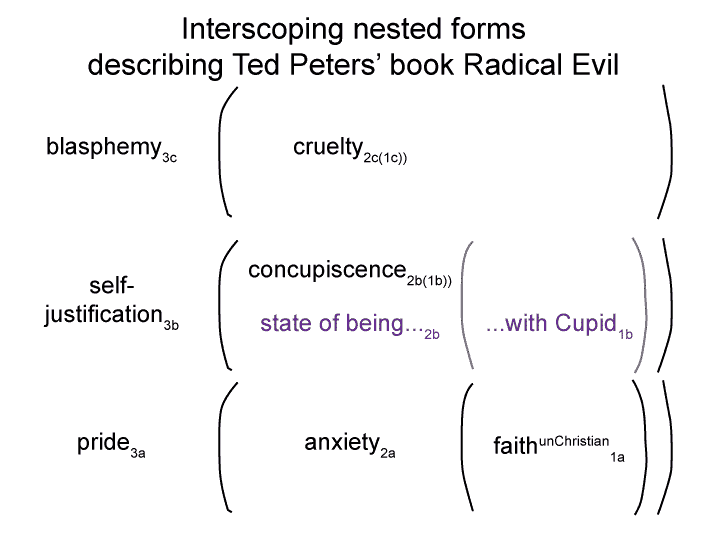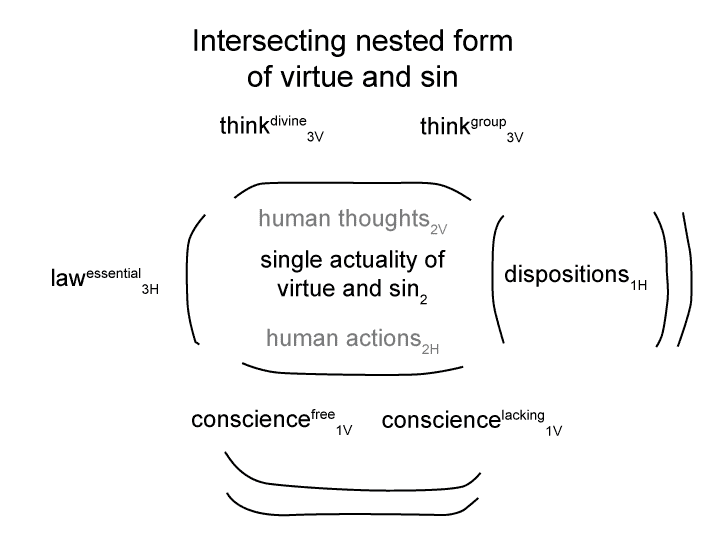Man and Sin by Piet Schoonenberg (1964) 2.3 AJ
Summary of text [comment] page 80
‘Evil attitudes and dispositions’ allow us to appreciate what is involved with the Scripture’s use of the words ‘flesh’, ‘concupiscence’, ‘bondage under the devil’ and ‘bondage under sin’.
[These all describe actuality emerging from possibility.
Ted Peter’s 1994 book Radical Evil portrays this. His work has already been analyzed with the nested forms.
Concupiscence belongs to the situation level of an interscope precisely as actuality emerging from and situating possibility (that is, concupiscence2(1)).
Indeed, the origin of the word ‘concupiscence’ is ‘the state of being2 with Cupid1’.
The complete situation level of the interscoping form follows:
Self-justification3b(the state of being…2b( potential …with Cupid1b))]
Man and Sin by Piet Schoonenberg (1964) 2.3 AH
Summary of text [comment] page 80
An evil attitude accompanies sinful action, combining with our inability for the good.
Every sin produces a persistent attitude that further consolidates sinful drives and inclinations. Persistent attitudes resist personal integration. One’s powers, tendencies, instincts, and passions demand their own satisfactions, even at the expense of the total value of the individual and community.
Man and Sin by Piet Schoonenberg (1964) 2.3 AG
[A particular sinful act may be forgotten, but sinful attitudes remain. The sinful act substantiates the sinner’s normal context. The act habituates the sinner’s potential.
This will be reflected in the way the person recites what is good and what is bad.
As the human acts and thinks, the entire intersecting nested form alters.
As actions and thoughts emerge from and situate possibilities, the possibilities become more and more pronounced.
The dispositions become trained.
The conscience becomes more specified. I label this consciencespecified.
Murder emerges from and situates the attitude of hatred.
Impurity emerges from and situates the attitude of narcissism.]
Man and Sin by Piet Schoonenberg (1964) 2.3 AD
[Come to think of it, sensible construction based on private or closely shared social constructions comes in handy for taking advantage of the ideological frameworks of others.
Hey, I can use widely held social constructions in order to cultivate my own wealth or status.
For example, consider the ambitions of state academics.
They pretend that their sensible constructions are not built on social constructions. They pretend that they are ‘not religious’, because that is the current opiate of the masses. Plus, their closely shared religious beliefs are unlikely to be challenged.
They can proselytize without risk.]
Man and Sin by Piet Schoonenberg (1964) 2.3 AC
[Infrasovereign thinkpro-objects permeate this Age, interpellating adherents of the Zeitgeist and denigrating thinkdivine.
Adding to the confusion, we rely on the our ability to make sense of language. We fall back on our apparently sensical sensible constructions and ignore the apparently nonsensical social constructions underlying any contemporary ideology.
We treat the words of contemporary ideologies as if they referred to things (and they do, but those actualities are themselves social constructions).
Our innate ability to respond to ‘talk as if it made sense’ cannot confront ‘the underlying nonsense that, once presumed, supports sensible construction’.]


